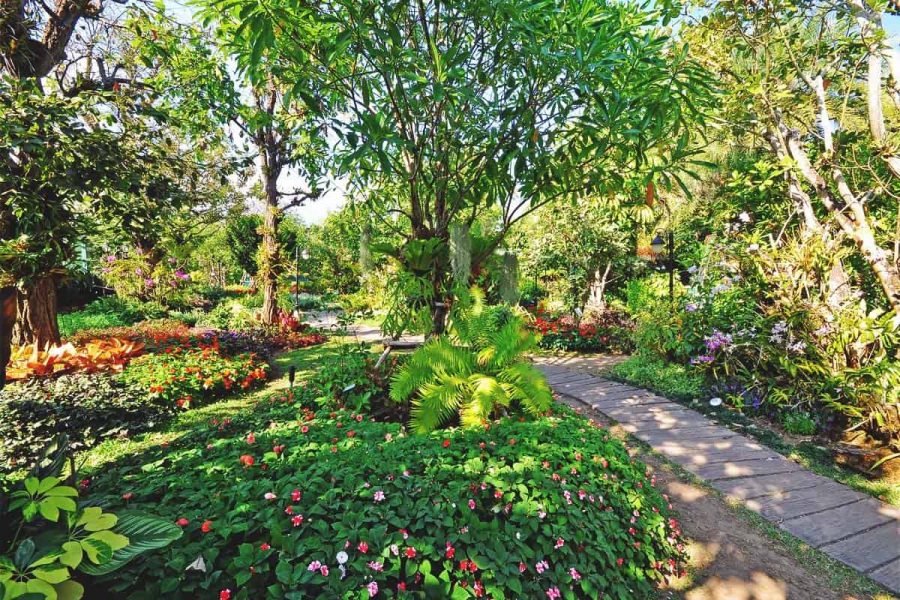Food Forests
May 6, 2020
Forests are known for their heavy abundance of life, their existence as a space that thrives quite wonderfully with no purposeful maintenance. They’re excellent settings for all your horror and fantasy needs, but most do not think of them as reliable food sources for kitchen and commercial use. Thus, people settle with neatly arranged monocultures of gardens, fields, and orchards. Admittedly, these traditional gardens take quite a bit of effort to maintain, but they work, so they continue to roll with it. Some are starting to turn this concept on its head, though, giving rise to forest gardening.
Living up to its name, forest gardening is essentially cultivating a garden in a forest format. Gardeners seek to emulate the typical, overcrowded, self-managing nature of a forest, but instead growing desired and edible plants. Sustainable America defines it as “a highly integrated community of plants.” When planning such gardens, the person thinks in accordance with forest layers, planning for multiple levels instead of the typical one or two. The seven layers consist of the overstory layer, the understory layer, the shrubs, the herbaceous layer, the root layer, the soil surface, and the vertical layer, according to Permaculture News. This accounts for various types of trees, bushes, flowers, and vines, so one can have their apple trees, carrots, rosemary, and cabbages grow in the same space. It differs from people simply placing two plants together in the fact that the goal is to establish an ecosystem, not make use of intercropping.
The resulting forest has high biodiversity and is typically quite dense, so it gives back an abundant amount and, if planned right, can do so throughout the year. The self-management stems from multiple factors: reseeding, pest control, soil repair, and disease. Traditional gardens often include quite a bit of work to keep it functional and healthy; monocultures (think rows upon neatly organized rows of cabbages) don’t naturally exist, so they simply seem like an easy feast for pests. Nothing exists there to ward them off, so the farmer/gardener must do it themselves.
Diseases can also hop easily from one plant to another.
Not to mention, all this growth of a single plant for years on end will drain a patch of land of its nutrients, so it must be replenished in some way. Any chemicals used will also add to the worsening of the soil. Farmers sometimes alternate crop fields or have specific fields to use in specific years to achieve this, but most just mix in fertilizer. People do make use of companion planting, where plants that benefit each other are grown together, to fight pests off, but not to the extent of a food forest. Plants in biodiverse situations tend to be more resilient, and those in forests even more so. Natural predators end up managing pests in forests and disease is harder to spread, as it is in normal forests. The high density and ground cover enriches the soil and keeps a system of composting going, while also choking out potential weeds. Essentially, the gardener doesn’t need to do much work at all to keep the forest running after it establishes itself, but they will still get an abundance of crops!
Food forests aren’t anything new, but the rise of permaculture has perhaps pushed more people to realize it as a viable form of planting. This, as mentioned before, is part of a design strategy called permaculture. It seeks to create things in a way that mimics nature, ultimately establishing a closed, sustainable system with no waste. It follows the philosophy of working with nature, allowing natural processes to take its place instead of micromanaging everything. Needless to say, it’s quite obvious how the popularization of food forests have sprung from this idea. There exists a food forest in Morocco and another in Vietnam, both hundreds of years old, and ancient cultures often made use of forest management to grow desired plants. The idea of planting in tandem with nature has been largely ignored in favor of fields, but with more people growing environmentally conscious, it seems that such ways are becoming popularized again.
A food forest takes a lot of effort before it establishes itself, though, as one needs to plan well and shelter the first seedlings from harm, not to mention how most don’t have the space to plant one anyway. Yes, forests don’t have a set size and your backyard would be suitable enough, but that’s whether you have a viable backyard. But, if one wishes to grow one anyway, they’ll find themselves with a bountiful harvest and a wonderful forest in a few years’ time!
Picture courtesy of MORNINGCHORES.COM

